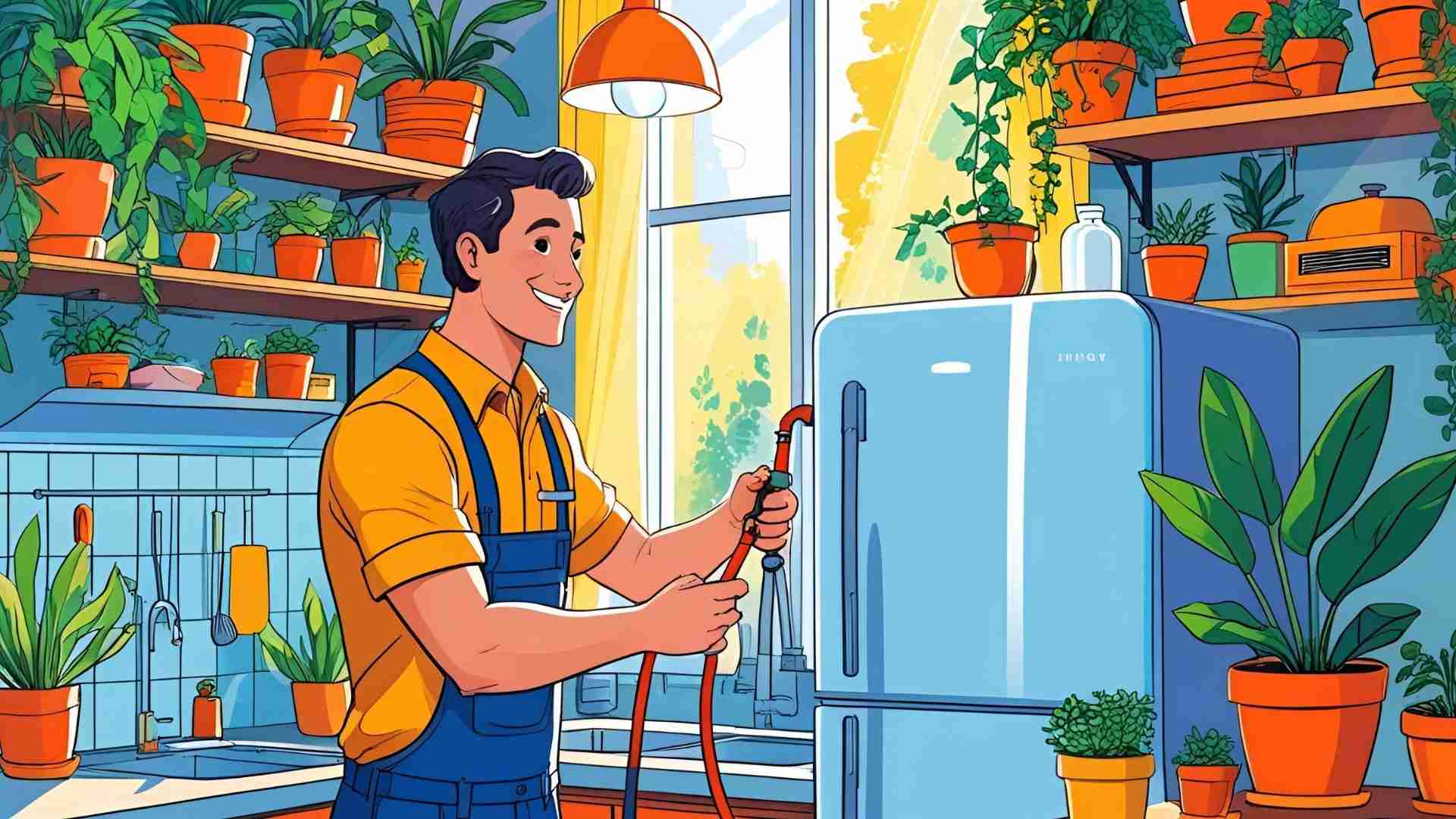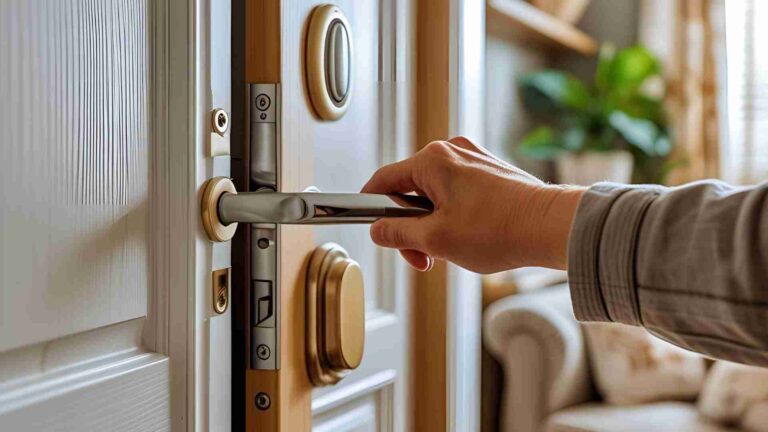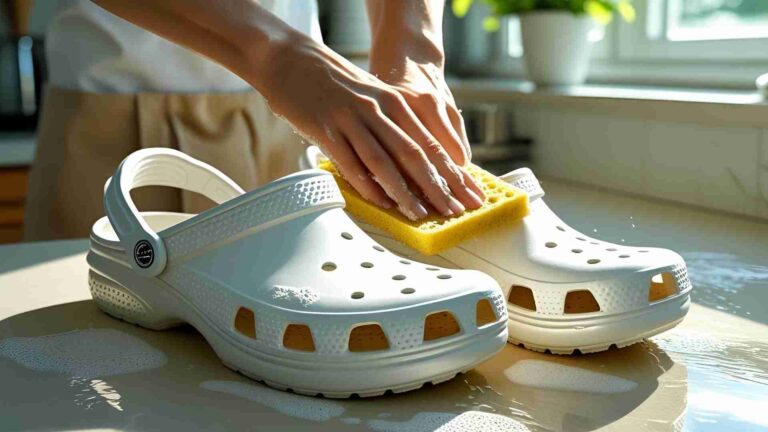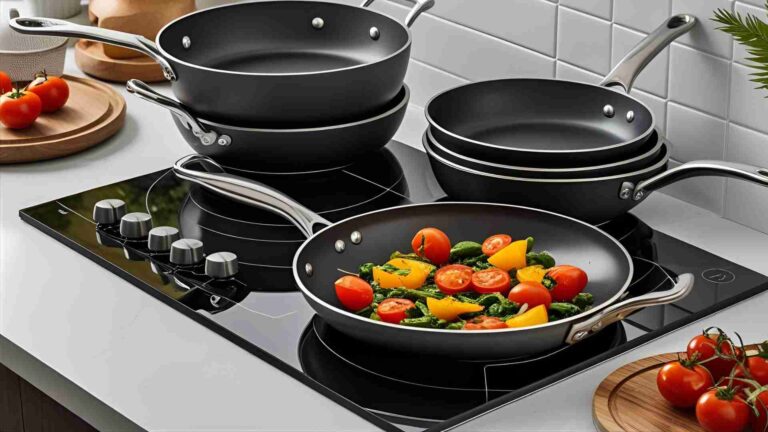Do you have to connect water line to fridge?
Learn if a refrigerator water line is necessary, its benefits, risks, and installation process. Explore alternatives and maintenance tips for optimal performance.
Refrigerators with built-in water dispensers and ice makers are a modern convenience, offering chilled water and fresh ice at the touch of a button. However, a common question arises: Do you have to connect a water line to a fridge with these features? If you choose not to use the dispenser or ice maker, will running the fridge without a water line cause damage? This article provides an in-depth exploration of refrigerator water lines, their purpose, pros and cons, installation process, maintenance, and alternatives. Whether you’re a homeowner upgrading your kitchen or a renter weighing options, this guide will help you make an informed decision.
Understanding the Purpose of a Refrigerator Water Line
A refrigerator water line is a plumbing connection that supplies water to specific fridge features. Contrary to a common misconception, the water line is not required for the refrigerator’s core cooling function. Refrigerators use refrigerants, condensers, and evaporators to maintain cold temperatures, not water. So, what exactly does the water line do?
Key Functions of a Refrigerator Water Line
- Ice Maker: The water line delivers tap water to the freezer’s ice maker, enabling automatic ice production.
- Water Dispenser: It provides chilled, filtered water through the fridge’s dispenser.
- Defrosting (Rare Cases): Some models use water to assist in defrost cycles, though this is less common.
Without a water line, these features cannot function, but the refrigerator’s ability to cool and freeze remains unaffected.
Do You Need to Connect a Water Line?
The short answer is: No, you don’t have to connect a water line to a refrigerator, even if it has a water dispenser or ice maker. These features are optional, and the fridge will operate normally without them. However, there are nuances to consider.
When a Water Line Is Necessary
If you want to use the ice maker or water dispenser, a water line connection is essential unless your refrigerator has a built-in water reservoir. Most modern refrigerators with these features are designed to connect to a home’s cold water supply via a ¼-inch tubing.
When a Water Line Is Optional
If you don’t plan to use the ice maker or water dispenser, you can skip the water line entirely. For example:
- You prefer using ice trays or a countertop ice maker.
- You rely on a separate water pitcher or faucet filter for chilled water.
- Your kitchen lacks a nearby water source, making installation impractical.
Running a refrigerator without a water line will not damage it, as these features are independent of the cooling system. However, some electronic models may display error codes if the ice maker is left on without water. To avoid this, ensure the ice maker is turned off, either via a switch inside the fridge or through the control panel.
Pros and Cons of Connecting a Refrigerator Water Line
Deciding whether to connect a water line involves weighing the benefits against potential drawbacks. Below is a detailed breakdown.
Benefits of a Water Line
- Convenience: Instant access to fresh ice and chilled, filtered water without manual effort.
- Space Efficiency: Eliminates the need for countertop ice makers or water pitchers, freeing up kitchen space.
- Energy Efficiency: Some models with built-in ice makers are more energy-efficient than standalone units.
- Enhanced Features: Water lines enable advanced features like craft ice or dual ice makers in premium models.
Drawbacks of a Water Line
- Risk of Leaks: Improperly installed or aging water lines can leak, potentially causing water damage or mold growth.
- Maintenance Costs: Ice makers require regular maintenance, such as filter replacements, which can add to long-term expenses.
- Installation Costs: If your kitchen lacks an existing water line, professional installation can cost $100–$500, depending on complexity.
- Reduced Storage Space: Ice makers and water dispensers occupy valuable freezer and door space.
Table: Pros and Cons of Refrigerator Water Lines
| Aspect | Pros | Cons |
|---|---|---|
| Convenience | Instant ice and water on demand | Requires installation and maintenance |
| Space | Frees up counter space | Reduces freezer/door storage capacity |
| Cost | No need for separate appliances | Potential installation and repair costs |
| Reliability | Modern systems are reliable when installed correctly | Risk of leaks or malfunctions |
Should You Get a Refrigerator with a Water Line?
The decision to choose a refrigerator with a water line depends on your lifestyle, kitchen setup, and budget. Here’s a guide to help you decide.
When to Choose a Refrigerator with a Water Line
- Existing Plumbing: If your kitchen already has a water line (e.g., behind the fridge or under the sink), connecting it is straightforward and cost-effective.
- Frequent Ice/Water Use: If you regularly use ice for drinks, entertaining, or cooking, an automatic ice maker is a time-saver.
- Preference for Integrated Features: A built-in dispenser enhances kitchen aesthetics and functionality.
When to Skip the Water Line
- Limited Ice/Water Needs: If you rarely use ice or prefer filtered water from a pitcher, a water line may not be worth the hassle.
- No Nearby Water Source: Installing a new water line can be expensive, especially in older homes or rentals.
- Maintenance Concerns: If you want to avoid potential leaks or filter replacements, a simpler refrigerator model may be better.
- Space Constraints: Opting for a model without an ice maker or dispenser maximizes storage capacity, especially in French door refrigerators.
Alternatives to a Water Line
- Manual Ice Trays: Simple and cost-effective, though less convenient for large quantities.
- Countertop Ice Makers: Portable units that don’t require plumbing, ideal for occasional use or small kitchens.
- Water Pitchers: Filtered pitchers stored in the fridge provide chilled water without a dispenser.
- Reservoir-Based Refrigerators: Some models have built-in water tanks, eliminating the need for a water line while retaining dispenser functionality.
Will Not Connecting a Water Line Prevent Mold or Leaks?
A common concern is whether skipping the water line reduces the risk of mold or leaks. Let’s address this.
Mold Risks
Mold in refrigerators typically results from condensation or improper cleaning, not the water line itself. Modern refrigerators are designed to minimize mold growth, even with a connected water line. However, if the water line is poorly maintained (e.g., stagnant water or clogged filters), it could contribute to mold or bacterial growth. Regular maintenance, such as cleaning the dispenser with a bleach-water solution and replacing filters every 6 months, mitigates this risk.
Leak Risks
Water lines can leak due to:
- Improper Installation: Loose connections or low-quality tubing increase leak risks.
- Aging Components: Over time, plastic or copper lines may degrade, especially in older refrigerators.
- Malfunctioning Valves: Faulty valves inside the fridge can cause flooding, though this is rare in modern models.
Not connecting the water line eliminates these risks entirely, as there’s no water flow to worry about. However, with proper installation and maintenance, leaks are uncommon in modern refrigerators from reputable brands like LG, Samsung, or Whirlpool.
Consumer Reports Insights
According to Consumer Reports, 21% of refrigerator models experience issues with dispensing water or ice, and 14% have problems producing ice. These statistics highlight that while water line issues are not universal, they are a notable concern. Choosing not to connect the water line can bypass these potential problems, especially if you don’t need the features.
How to Install a Refrigerator Water Line
If you decide to connect a water line, the process is manageable with the right tools and planning. Below is a step-by-step guide for installing a ¼-inch water line, commonly used for refrigerators.
Tools and Materials Needed
- Tools: Tape measure, tube cutter, adjustable wrench, hole saw, power drill, screwdriver.
- Materials: ¼-inch copper, plastic, or braided stainless steel tubing, tee fitting stop valve, nylon cable clamps, sealing tape, water pitcher or bucket.
- Optional: Water leak detector, appliance drip tray.
Step-by-Step Installation
1. Plan the Route:
- Map the shortest path from the water source (e.g., sink shut-off valve or nearby pipe) to the refrigerator.
- Ensure the path avoids wiring or other plumbing.
- Purchase enough tubing (plus 6–8 feet of slack) to allow refrigerator movement.
2. Turn Off the Water Supply:
- Shut off the water at the sink’s shut-off valve or the home’s main water supply.
- Drain residual water by running the faucet.
3. Tap into the Water Supply:
- Option 1: Sink Shut-Off Valve:
- Disconnect the sink’s water supply line.
- Attach a tee fitting with a ¼-inch outlet to the shut-off valve.
- Reconnect the sink’s supply line and attach the refrigerator water line to the tee’s third outlet.
- Option 2: Direct Pipe Tap:
- Locate a nearby cold water pipe.
- Drill a ¼-inch hole and install a stop tee valve or self-tap saddle valve.
- Secure the valve to the pipe.
4. Run the Water Line:
- Feed the tubing along the planned path, drilling holes through cabinets or floors as needed.
- Secure the tubing every 2–3 feet with nylon clamps to prevent kinking.
5. Connect to the Refrigerator:
- Wrap the refrigerator’s water inlet threads with sealing tape.
- Attach the tubing to the inlet using a compression nut, tightening with a wrench (avoid over-tightening).
6. Test the System:
- Turn the water supply back on.
- Flush 1–2 gallons of water through the dispenser to clear air and debris.
- Discard the first 2–3 batches of ice.
- Check all connections for leaks and tighten as needed.
Diagram: Refrigerator Water Line Installation
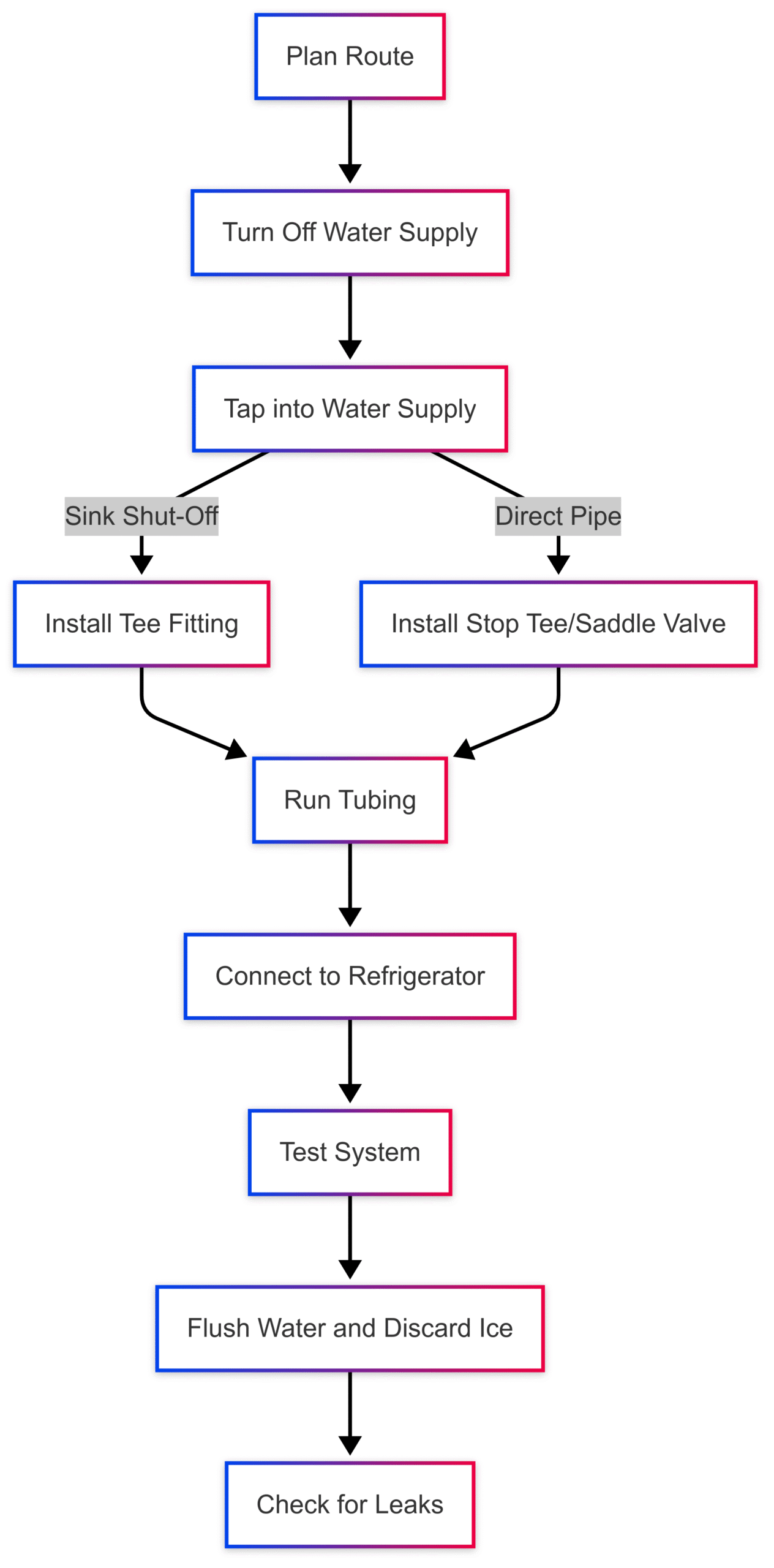
Installation Tips
- Choose Quality Materials: Copper tubing is durable and prevents off-tastes, while braided stainless steel is less prone to leaks but more expensive.
- Check Local Codes: Ensure compliance with the International Plumbing Code and local regulations.
- Add a Leak Detector: Place a water leak detector or drip tray under the fridge for added protection.
- Insulate in Cold Climates: Use foam insulation to prevent the water line from freezing.
Maintenance and Troubleshooting
Regular maintenance is crucial to prevent issues like leaks, mold, or poor performance. Here are key tips and warning signs to watch for.
Maintenance Tips
- Inspect Regularly: Check the water line and connections every 6 months for signs of wear or leaks.
- Replace Filters: Change water filters every 6 months or as recommended by the manufacturer (cost: $20–$60 per filter).
- Clean the Dispenser: Use a 1:10 bleach-water solution to clean the dispenser and prevent mold.
- Vacuum Coils: Dust the water line coils to maintain efficiency.
- Insulate Lines: In cold climates, insulate the water line to prevent freezing.
Warning Signs of Water Line Issues
- Low Water Pressure: Indicates a clog, mineral buildup, or leak.
- Strange Odors/Tastes: Suggests contamination, mold, or a deteriorating line.
- Visible Leaks/Moisture: Puddles, dampness, or baseboard damage signal a leak.
- Noisy Operation: Banging or hissing may indicate air in the line or a faulty valve.
- Smaller Ice Cubes: Suggests a malfunctioning valve or restricted water flow.
Table: Common Water Line Issues and Solutions
| Issue | Possible Cause | Solution |
|---|---|---|
| Low Water Pressure | Clogged filter or mineral buildup | Replace filter or flush line |
| Strange Odors/Tastes | Mold or contamination | Clean dispenser, replace line if needed |
| Visible Leaks | Loose connection or damaged tubing | Tighten connections or replace tubing |
| Noisy Operation | Air in line or faulty valve | Flush line or replace valve |
| Smaller Ice Cubes | Malfunctioning valve or low pressure | Inspect valve, check water pressure |
Cost Considerations
The cost of installing and maintaining a refrigerator water line varies based on materials, labor, and your kitchen’s setup.
Installation Costs
- DIY Installation: $20–$100 for materials (tubing, fittings, valves).
- Professional Installation: $100–$500, depending on plumbing complexity and labor rates.
- New Water Line Run: $200–$1,000 if no existing water line is available.
Maintenance Costs
- Water Filters: $20–$60 per filter, replaced every 6 months.
- Repairs: $50–$300 for fixing leaks or replacing components.
- Leak Detectors/Drip Trays: $20–$100 for added protection.
Refrigerator Price Comparison
Refrigerators with water lines are typically more expensive due to added features. Below is a sample comparison of popular models (prices approximate, sourced from major retailers):
| Model | Features | Price |
|---|---|---|
| LG LRFXS2503S (With Ice Maker) | Water dispenser, dual ice maker | $2,500 |
| Samsung RF28T5001SR (With Ice Maker) | Water dispenser, in-door ice maker | $2,200 |
| Whirlpool WRF535SWHZ (No Ice Maker) | No water line, more storage | $1,800 |
Addressing Common Concerns
Modern water lines, when installed correctly, rarely leak. Using high-quality materials like copper or braided stainless steel and ensuring tight connections minimizes risks. Regular inspections further reduce the likelihood of issues.
Mold is unlikely in a properly maintained water line. Stagnant water or neglected filters can increase the risk, but cleaning and filter replacements prevent this.
Some ice makers can be removed to reclaim freezer space, typically requiring just a few screws and a connector. However, in-door ice makers (common in LG models) may be integrated with shelves, making removal less practical. Check your model’s manual for guidance.
Expert Insights and Community Feedback
Community discussions, such as those on platforms like Reddit’s r/Appliances, reveal varied perspectives:
- Maintenance Concerns: Users like Tyler Shellberg note that ice makers increase long-term maintenance costs but rarely cause catastrophic failures.
- Historical Issues: Older refrigerators (1970s–1980s) had a reputation for leaks and mold, but modern designs have largely resolved these, per user bta.
- Space Trade-Offs: Ecnerwal highlights that ice makers reduce freezer space and may require costly filter replacements.
- Convenience Factor: Mazura emphasizes the joy of instant ice, suggesting that those unaccustomed to it may not realize its value.
These insights underscore the importance of weighing convenience against maintenance and space considerations.
Conclusion
Connecting a water line to your refrigerator is optional and depends on your needs, kitchen setup, and willingness to maintain the system. If you value the convenience of a water dispenser and ice maker, a properly installed water line offers significant benefits. However, if you prefer simplicity, space efficiency, or want to avoid potential leaks, skipping the water line or opting for alternatives like ice trays or countertop ice makers is a viable choice. Modern refrigerators are designed to operate safely without a water line, so there’s no risk of damage if you choose not to connect one.
For those opting for a water line, careful installation and regular maintenance are key to preventing issues. By understanding your options and planning accordingly, you can ensure your refrigerator meets your household’s needs while maintaining reliability and efficiency.
For professional assistance with water line installation or repairs, contact trusted services like Metro Flow Plumbing at 214-214-4718. Enjoy the convenience of fresh ice and water, or embrace the simplicity of a water-line-free fridge—the choice is yours.
Please share this Do you have to connect water line to fridge? your friends and do a comment below about your feedback.
We will meet you on next article.
Until you can read, Cold Water Not Working on Washing Machine
